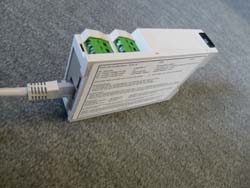 iBOX-2S
iBOX-2S Advanced
presentation of data is possible via online graphs, alphanumeric webdisplay
or graphic webdisplay, see website www.ekopower.nl
Setting Time and Control of switches can ONLY be carried out via the webserver!
Automatic (DAILY) UTC time/date synchronisation is a new feature
and can be activated using the
control software (Ethernet settings) or by using the webserver . The
UTC synchronisation takes
place during sending a file with current values (must ALSO be activated using
the control software!).
In
version 8 and higher firmware there is also a possibility to log the values at fixed 10
minutes intervals,
and logging exactly at eg 10:00, 10:10 , 10:20 etc. In this way logger networks
can be synchronised
and correlation with eg meteo stations is possible.
The embedded webserver can also be used remote over the internet
so the below mentioned parameters can also be changed online,
see the instructions mentioned in the hardware manual, see the link below
Quick and easy adjusting of parameters can also be carried out using the
(supplied) iBOX-EKO21N control software (prepare SD card with logger parameters).
Moreover additional parameters can be entered, like:(see also the table below)
- ip address of the iBOX
- alarm settings etc. can be entered (if implemented)
- duration of time the (wireless 3G/GPRS) router is switched on
- ultra low power consumption for remote or mobile applications
- ranges, units and quantities can be changed (password protected)
for eg general inputs (like 4..20 mA , 0..5/10V etc.)
Overview of parameters which can be entered via webserver or via prepare SD card, see table below
Besides a webserver the iBOX has also an embedded FTP client ,which can send
files automatically to
a server or to the free FTP Cloud. Note that the files send via FTP are in
sectors of 512 bytes, so it is not
possible to send it frequently: each 10 minutes is a practical value (also for
updating optional online graphs.
A practical tool for combining of downloaded files to
one file is available, see manual
here
Note: do not include incomplete uploaded files
in the file combine utility as (after the data is resend)
this will prevent double values in the
combined file. Download this program
here
So at first inspect the data files before using the file combine
function!
Uploaded files
* when an uploaded file to the server could not be completed, the complete
file willl be resend
during the next session and the incomplete file will stay at the server
* when it is - temporary- not possible to send a data file to the server, the
data is stored
at the SD card and will be send when it is possible again.
* reasons for not successful uploads can be: bad or no internet connection, no
cover
of GPRS/3G in case of use of a 3G router , server not available etc.
The webserver is NOT available during FTP sessions, so keep this limited or
disable it.
When the webserver is not to access try to restart the browser or use Control F5
For more detailed information see online manual
(hardware & software)
| logger pararameter: | possibilities iBOX |
| time and date 1) | via webserver or UTC time /date
sync is active if selected AND upload to server is activated, see note *) below |
| sample interval | via webserver and via SD card |
| record interval | via webserver and via SD card |
| upload interval | via SD card (sending datafiles and current values may have different intervals) |
| ip address/map server/etc. | via SD card |
| ip address of system | via SD card |
| set input type and nr 2) | via SD card |
| ranges and units 2) | via SD card |
| sample/record delay 2) | via SD card |
| set alarm conditions 2) 4) | via SD card |
| sms alarm message 4) | (via forwarded email) |
| email alarm message 4) | via SD card |
| description of logger | via SD card |
| timer switch settings & low power mode 4) | via SD card (switching GPRS/3G router) |
| operation & actions | |
| controlling outputs 4) | via webserver (also over internet!) |
| clear card | via webserver and via SD card |
| read values and status | via webserver
and via optional online webdisplay / graphs |
| upload data to specified server/directory 3) | automatically via FTP or
via webserver data can also be transferred to PC via the SD card |
| NOTES |
Two way
communication: A Data to server (via FTP) B Webserver (via LAN or via internet) The webserver is also remote available via internet using wireless GPRS/3G router and sim card has fixed ip nr 1) by setting time and date the system will restart, in this way it is also possible to set a start time (eg 12:00) for synchronisation. Also the upload time can be changed in this way *) Daily UTC time synchronisation can be activated, starting at the first upload of the current value file (after power up) UTC sync must set active before preparing a SD card AND the system must be able to upload to a FTP server! 2) password protected 3) a practical tool for combining of downloaded files to one file s available, see manual here 4) some mentioned features may not yet be available as each system is supplied according your specifications |
See below the parameters which can be entered via the embedded webserver: